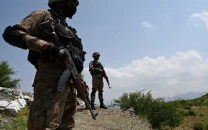Panjkora River: a shadow of its former self
A drastic decline of 80% occurred in its trout population because of pollution

Panjkora, the once majestic river of Dir district, has fallen victim to negligence and apathy, transforming into a distressing dumping ground for solid waste, gutters, and wastewater. This unfortunate state not only tarnishes its natural beauty but also poses a severe threat to the water quality, silently inviting catastrophe without garnering the attention it deserves.
In its pristine state, the Panjkora River was renowned for its crystalline waters, flowing gracefully through the picturesque landscape. The icy water of the river was home to a diverse range of fish, notably including various species of trout, which thrived in its clean and unpolluted environment.
Originating from the highlands of Kumrat, nestled in the magnificent Hindukush mountain range, the Panjkora River meandered its way for 220 kilometers. As it traversed through the awe-inspiring Kumrat Valley, Dir Upper, and Dir Lower districts, it showcased its natural grandeur, captivating the hearts of locals and visitors alike. Eventually, the river joined forces with the mighty River Swat in Matkani, Malakanad, forming a harmonious union of waters.
However, the current state of the Panjkora River paints a grim picture. Instead of flowing freely with pristine waters, it now suffers from a grave predicament. The negligence of individuals and authorities has allowed solid waste, gutters, and untreated wastewater to be indiscriminately dumped into its once-glistening depths.
Talking to The Express Tribune Professor Ijaz Ahmad said that Panjkora is derived from Persian. “Panj means five and Kor means flowing water,” he said, adding that along this river was small track in the ancient times used for trade between Punjab in India and Kashghar in China.
“This mountainous track was part of silk route and later it was replaced with modern roads during the British Raj. It is called Panjkora because five streams combine in the mountains and make this river,” he said.
Till 1970s the water was clear of any pollution and used for drinking. Still there are 130 water mills along its banks.
“The total flow of water in this river is 15,000 to 20,000 cusecs in total while each tributary brings around 3,000 to 5,000 cusecs of water,” said Assistant Engineer Irrigation Nasir Khan, adding that in the 2010 and 2022 floods the water level reached 160,000 cusecs, bringing widespread destruction to the human settlements along its banks.
Assistant Director Agriculture Pervaz Khan said that the river irrigates around 56,000 acres of land.
In the past few decades there is a 80 per cent decline in the trout fish population in the river due to polluted water as well as encroachments. All the waste water from the local gutters is directly dumped into the river without treatment and several slaughterhouses are also functional along the banks.
Published in The Express Tribune, May 29th, 2023.



















COMMENTS
Comments are moderated and generally will be posted if they are on-topic and not abusive.
For more information, please see our Comments FAQ